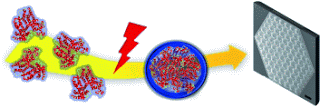Angewandte Chemie International Edition – Proteins in focus: Dynamically tunable protein microdevices were built up by a simple “top-down”, maskless, femtosecond laser direct writing approach with bovine serum albumin. This technique was used to produce biocompatible microlenses that swell and shrink reversibly in response to changes in the pH of the surrounding solution. These responses to environmental stimuli can be used to focus the microlenses.
The researchers used a laser to “write” the desired micrometer-sized lens shape out of a solution of bovine serum albumin, a protein. Methylene blue acts as a photosensitizer, which captures the light energy like an antenna and triggers a crosslinking reaction of the protein molecules. Driven by a computer, the laser cuts out the desired three-dimensional form voxel by voxel. A voxel is a three-dimensional pixel, a tiny segment of volume. The irradiation used is in femtosecond pulses, which lasts on the order of 10^-13 seconds. The crosslinking reaction only takes place in the locations that are irradiated. After the reaction, the protein molecules that have not reacted can simply be rinsed away. What stays behind is a cross-linked, aqueous protein gel in the shapes of micrometer-sized lenses.
10 pages of supplemental information
If you liked this article, please give it a quick review on ycombinator or StumbleUpon. Thanks

Brian Wang is a Futurist Thought Leader and a popular Science blogger with 1 million readers per month. His blog Nextbigfuture.com is ranked #1 Science News Blog. It covers many disruptive technology and trends including Space, Robotics, Artificial Intelligence, Medicine, Anti-aging Biotechnology, and Nanotechnology.
Known for identifying cutting edge technologies, he is currently a Co-Founder of a startup and fundraiser for high potential early-stage companies. He is the Head of Research for Allocations for deep technology investments and an Angel Investor at Space Angels.
A frequent speaker at corporations, he has been a TEDx speaker, a Singularity University speaker and guest at numerous interviews for radio and podcasts. He is open to public speaking and advising engagements.



